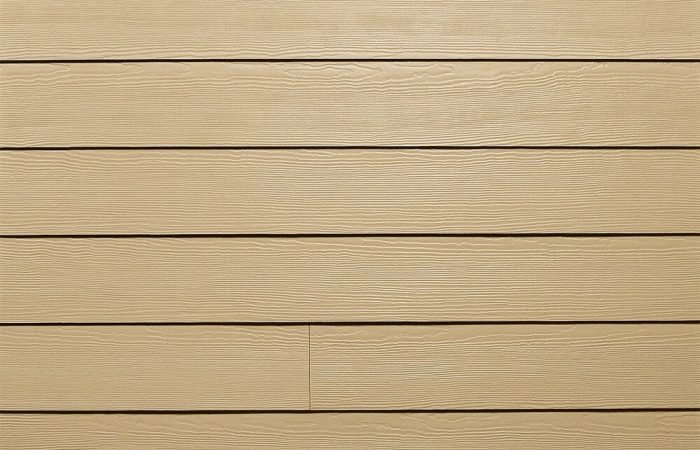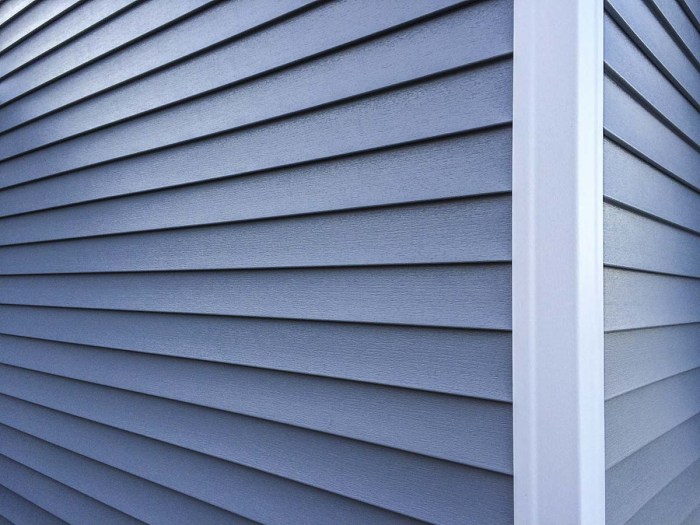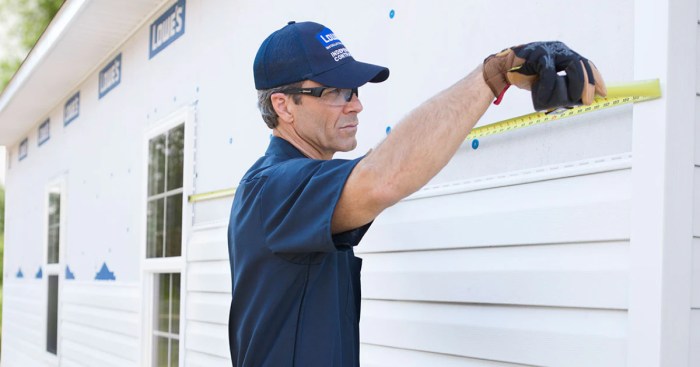Lowes Siding Estimate Your Guide

Lowes siding estimate – Lowe’s siding estimate: Thinking about new siding? Getting a solid estimate is key. This guide walks you through everything you need to know about getting a Lowe’s siding estimate, from understanding their services and materials to analyzing the final cost breakdown and preparing for installation. We’ll cover everything from choosing the right siding material to negotiating the best price, ensuring you’re well-prepared for your home improvement project.
We’ll explore the different siding options Lowe’s offers, including vinyl, fiber cement, and wood, and detail how factors like material choice, labor costs, and project complexity influence the final estimate. We’ll also provide tips for asking the right questions and spotting potential hidden costs. Getting a clear picture upfront saves headaches later!
Understanding Lowe’s Siding Services
Lowe’s offers a comprehensive range of siding services, from material selection and supply to professional installation and warranty support. Understanding these services is crucial for homeowners undertaking exterior renovations. This section details Lowe’s offerings and compares them to competitors.
Siding Materials Offered by Lowe’s
Lowe’s provides a variety of siding materials to suit different budgets and aesthetic preferences. They typically stock popular options like vinyl, fiber cement, and engineered wood siding. Vinyl siding is known for its affordability and low maintenance; fiber cement offers durability and a more natural look; while engineered wood provides a wood-like appearance with improved resistance to moisture and insects. The specific availability of materials may vary by location. Customers can consult with Lowe’s staff to determine which siding best fits their needs and local climate.
Siding Installation Services Provided by Lowe’s
Lowe’s offers various siding installation services, ranging from complete project management to individual installation tasks. They typically employ or contract with experienced installers, and some locations may offer design consultation to help customers choose the best siding style and color for their home. Services often include removal of old siding, proper installation of new siding, and cleanup of the worksite. The level of service offered can vary based on location and project complexity. For larger projects, a detailed contract outlining all aspects of the installation is usually provided.
Lowe’s Warranty and Guarantee Options for Siding Projects
Lowe’s typically offers warranties on both the materials and the installation provided by their contractors. The specific terms and conditions of these warranties vary depending on the chosen materials and the contractor involved. It’s crucial to review the warranty documentation carefully before committing to a project. Lowe’s may offer extended warranties for an additional cost, providing longer-term protection against material defects and installation issues. Homeowners should clarify all warranty details with Lowe’s before starting the project.
Comparison of Lowe’s Siding Services to Competitors
Lowe’s competes directly with Home Depot in the home improvement market, and both offer similar siding materials and installation services. However, the specific offerings and pricing can vary between locations. Both retailers typically provide a range of siding options, from budget-friendly vinyl to higher-end fiber cement. A direct comparison of pricing and service offerings requires checking individual Lowe’s and Home Depot locations. Factors such as the contractor’s experience, project complexity, and regional pricing will impact the final cost. It’s advisable to obtain multiple quotes from different contractors and retailers before making a final decision.
Obtaining a Lowe’s Siding Estimate

Source: allstarwindowsiding.com
Getting an accurate estimate for your new siding is crucial for budgeting and planning your project. Lowe’s offers in-home consultations and online tools to help you understand the costs involved. This section will guide you through the process of requesting a siding estimate from Lowe’s.
Requesting a Lowe’s Siding Estimate: A Step-by-Step Guide
To initiate the process, you can choose between contacting Lowe’s directly through their website or visiting a local store. The online method offers convenience, while an in-person visit allows for immediate interaction with a Lowe’s associate. Regardless of your chosen method, be prepared to provide key information about your project.
Information Required for an Accurate Estimate
Lowe’s will need specific details to provide an accurate estimate. This typically includes the dimensions of your home’s exterior walls, the type of siding you’ve chosen (e.g., vinyl, fiber cement, wood), the desired color and style, and any additional features like trim or accessories. Accurate measurements are essential; providing rough estimates could lead to inaccurate pricing. Photographs of your home’s exterior, especially areas with complex features, can also be beneficial. Finally, you should be prepared to discuss your desired timeline for the project.
Questions Homeowners Should Ask About Siding Estimates
A detailed understanding of the estimate is vital. Therefore, homeowners should inquire about the breakdown of costs, including labor, materials, and any potential additional fees. They should also confirm the warranty offered on both materials and labor. Clarification on the project timeline and the expected duration of the installation process is also crucial. Finally, it is important to understand the payment options and payment schedule offered by Lowe’s.
Sample Communication for Initiating an Estimate Request
Here’s an example email you can adapt:
Subject: Siding Estimate Request – [Your Address]
Dear Lowe’s Siding Department,
I am interested in receiving a siding estimate for my home located at [Your Address]. My home is approximately [Square Footage] square feet with [Type of Siding] siding. I am interested in [Type of Siding] siding in the color [Color]. I am available for an in-home consultation on [Dates/Times]. Please contact me at [Phone Number] or [Email Address] to schedule an appointment.
Sincerely,
[Your Name]
Factors Affecting Siding Estimate Costs

Source: ecroofinginc.com
Getting an accurate siding estimate from Lowe’s (or any contractor) depends on several key factors. Understanding these factors will help you budget effectively and avoid surprises during the project. The final price isn’t just about the square footage; it’s a complex calculation involving materials, labor, and the specifics of your home.
Material Choices and Cost
The type of siding you choose significantly impacts the overall cost. Different materials vary dramatically in price per square foot, durability, and aesthetic appeal. Higher-end materials like fiber cement or cedar often come with a higher price tag but offer superior longevity and weather resistance. Vinyl, a more budget-friendly option, might require replacement sooner. The cost also depends on the style and color you select; some specialized finishes or textures may increase the expense.
Labor Costs and Project Complexity
Labor costs are a substantial part of your siding estimate. The complexity of your project directly influences the amount of labor required. Factors like the size of your home, the number of windows and doors, the condition of the existing siding (requiring removal and disposal), and the presence of intricate architectural details all contribute to the overall labor hours needed. A simple, single-story home with straightforward siding will generally require less labor than a multi-story house with complex trim and multiple architectural features. Furthermore, difficult-to-access areas, such as steep roofs or multiple stories, will also increase labor costs.
Project Complexity and Additional Services, Lowe’s siding estimate
Beyond the basic siding installation, additional services can increase the overall estimate. These could include: siding removal and disposal of old materials, repairs to underlying sheathing or wall structure, installation of flashing or trim, painting or staining the new siding, and cleanup after the project is completed. Any necessary repairs or unexpected issues discovered during the installation process will also add to the final cost. For example, discovering significant rotted wood beneath the old siding will necessitate additional time and materials to repair before new siding can be installed.
Siding Material Cost Comparison
| Material | Cost per sq ft (Estimate) | Pros | Cons |
|---|---|---|---|
| Vinyl | $3-$8 | Affordable, low maintenance, variety of colors and styles | Can be easily damaged, less durable than other options |
| Fiber Cement | $8-$15 | Durable, fire-resistant, low maintenance, long lifespan | More expensive than vinyl, requires professional installation |
| Wood (Cedar) | $10-$25+ | Beautiful aesthetic, naturally insulating, durable | High maintenance, susceptible to rot and insect damage, expensive |
| Aluminum | $6-$12 | Durable, low maintenance, fire-resistant | Can dent, limited color options, less aesthetically pleasing than wood or fiber cement |
Analyzing a Lowe’s Siding Estimate
Getting a detailed understanding of your Lowe’s siding estimate is crucial before you commit to the project. A thorough review will help you avoid unexpected costs and ensure you’re getting the best value for your money. This section will guide you through the process of analyzing your estimate effectively.
Estimate Components
A typical Lowe’s siding estimate will break down the costs into several key components. You’ll likely see line items for materials, such as the type and quantity of siding, underlayment, flashing, and trim. Labor costs will be a separate section, detailing the hours required for removal of old siding (if applicable), installation of new siding, and any necessary repairs. Permits and other associated fees, such as waste disposal, will also be included. Finally, a comprehensive estimate will provide a total cost, including sales tax. For example, you might see a breakdown showing $5,000 for materials, $3,000 for labor, $500 for permits, and $200 for waste disposal, totaling $8,700 before tax.
Identifying Potential Hidden Costs
While Lowe’s strives for transparency, some potential hidden costs might not be immediately apparent. Carefully review the estimate for any exclusions. For instance, the estimate might not include costs associated with complex repairs, such as rotted wood or extensive damage that requires extra work beyond the initial assessment. Similarly, unexpected issues discovered during demolition could lead to additional expenses. It’s important to ask clarifying questions about any ambiguous items or vague descriptions to avoid surprises later. For example, a vague line item like “Miscellaneous Repairs” should be clarified to understand its scope and potential cost. Always get a detailed explanation of any additional charges that arise during the project.
Comparing Estimate Options
Lowe’s may offer different siding options, each impacting the overall cost. Comparing these options is essential. For example, comparing a vinyl siding estimate to a fiber cement siding estimate will reveal significant differences in material cost, labor, and longevity. A lower upfront cost for vinyl might not reflect the longer-term cost of replacing it sooner compared to the more durable fiber cement. Consider the long-term value and cost-effectiveness of each option when making your decision. A table comparing material cost, labor cost, and projected lifespan can help you visualize the differences.
Estimate Review Checklist
Before signing anything, use this checklist to thoroughly review your Lowe’s siding estimate:
- Verify all materials listed: Ensure the type and quantity of siding, underlayment, and other materials match your expectations and project needs.
- Confirm labor costs: Check the number of hours allocated for each task and the hourly rate. Inquire about any potential overtime charges.
- Clarify permit fees: Confirm that all necessary permits are included in the estimate and understand what they cover.
- Identify potential hidden costs: Look for vague line items or exclusions that might indicate additional expenses.
- Compare different options: Analyze different siding materials and their impact on the total cost and long-term value.
- Review the payment schedule: Understand the payment terms and ensure they align with your budget.
- Read the contract carefully: Before signing, ensure you understand all terms and conditions.
Visualizing Siding Options: Lowe’s Siding Estimate

Source: lowes.com
Choosing the right siding for your home involves more than just picking a color; it’s about understanding how different materials and styles will impact your home’s overall look and feel. This section will help you visualize the various options available at Lowe’s, considering material, color, texture, style, and installation patterns.
Different siding materials offer unique aesthetic qualities. Understanding these differences is crucial for making an informed decision. Let’s explore some popular choices and their visual characteristics.
Siding Material Appearances
Vinyl siding is known for its smooth, clean look. It comes in a wide variety of colors and can mimic the appearance of wood or other materials. Fiber cement siding, on the other hand, offers a more textured, often wood-grain-like finish, providing a more substantial and upscale appearance. Wood siding, while beautiful and offering a natural look, requires more maintenance and comes with variations in color and grain that add to its character. Each material offers a distinct visual profile.
Siding Colors and Textures
The color and texture of your siding significantly influence your home’s curb appeal. Popular siding colors range from classic neutrals like white, beige, and gray, to bolder choices such as deep blues, greens, and reds. Textures vary from smooth, sleek surfaces to those that mimic the natural look of wood grain, stone, or stucco. Consider your home’s architectural style and surrounding landscape when selecting colors and textures to achieve a cohesive and visually appealing result. For example, a Craftsman style home might pair well with a deep brown wood-grain textured fiber cement siding, while a modern home could benefit from a clean, white vinyl siding.
Siding Styles and Associated Costs
The style of your siding can dramatically alter your home’s appearance. Below is a table outlining some common styles, materials, approximate costs (per square foot, subject to regional variation and project specifics), and a brief visual description. Remember that these costs are estimates and can fluctuate based on several factors, including labor, material availability, and project complexity.
| Style | Material | Approximate Cost ($/sq ft) | Visual Description |
|---|---|---|---|
| Clapboard | Vinyl | $4 – $8 | Overlapping horizontal boards creating a classic, traditional look. |
| Shake | Fiber Cement | $10 – $15 | Shingle-like appearance, often with a rough texture, offering a rustic or craftsman feel. |
| Board and Batten | Wood | $15 – $25+ | Vertical boards with narrow strips covering the seams, providing a clean, modern, or farmhouse aesthetic. |
| Vertical Siding | Vinyl | $5 – $9 | Vertical planks providing a contemporary and sleek appearance. |
Siding Installation Patterns and Visual Impact
The way siding is installed can significantly influence its visual impact. For instance, horizontal lap siding, the most common type, creates a clean, traditional look. However, vertical siding offers a more modern and contemporary feel. The choice of installation pattern should complement the overall architectural style of the home. Consider also the impact of varying board widths; wider boards can create a more bold statement while narrower boards provide a more subtle and refined look. A staggered installation pattern for lap siding, where the seams of each row are offset, can create a more visually interesting and less monotonous effect than a perfectly aligned pattern.
Preparing for Siding Installation

Source: lowes.com
Getting your house ready for new siding is crucial for a smooth and successful installation. Proper preparation minimizes potential delays and ensures the longevity of your new siding. This involves both exterior preparations and clear communication with your Lowe’s installation team.
Before the installation crew arrives, several key steps will help ensure a seamless process. These preparations are vital not only for a beautiful final result but also to protect your property and prevent unforeseen complications during the installation itself.
Exterior House Preparations
Preparing the exterior of your home is a significant step in the siding installation process. This involves several tasks that should be completed before the installation team begins work. Neglecting these preparations can lead to delays, additional costs, or even damage to your home.
- Clear the area: Remove all landscaping features, such as flowerbeds, garden ornaments, and patio furniture, from the immediate vicinity of the house. This provides ample working space for the installers.
- Trim overgrown vegetation: Shrubs and trees that overhang the house should be trimmed back to prevent interference with the installation process. This also prevents damage to the new siding.
- Protect windows and doors: Cover windows and doors with protective sheeting or masking tape to prevent damage from debris or accidental scratches during the installation. Consider using painter’s tape for delicate surfaces.
- Repair any existing damage: Address any damaged areas of existing siding, fascia, or trim. This includes repairing rotted wood, replacing damaged sections, or filling gaps and cracks. Unrepaired damage can compromise the integrity of the new siding installation.
- Remove any obstructions: Ensure that any outdoor lighting fixtures, security cameras, or other obstructions are either removed or properly protected during the installation.
Communication with Lowe’s
Maintaining open communication with your Lowe’s representative throughout the preparation phase is essential for a successful installation. This ensures everyone is on the same page and avoids misunderstandings or delays.
- Confirm the installation schedule: Confirm the exact date and time of the installation well in advance to allow ample time for preparation.
- Address any concerns: If you have any questions or concerns about the preparation process, contact your Lowe’s representative immediately. This proactive approach can prevent potential problems later on.
- Clarify expectations: Discuss any specific requirements or preferences you may have regarding the installation process. This includes details about access to your property, parking arrangements, or specific instructions for the installation crew.
- Confirm access points: Ensure the installation team has clear access to all areas of the house that require siding installation. This might include gates, pathways, or specific access points.
Pre-Installation Checklist
A comprehensive checklist ensures you’ve covered all bases before the siding installation commences. Using a checklist helps to avoid overlooking critical steps and potential issues.
| Task | Completed? | Notes |
|---|---|---|
| Cleared area around the house | ||
| Trimmed overgrown vegetation | ||
| Protected windows and doors | ||
| Repaired existing damage | ||
| Removed obstructions | ||
| Confirmed installation schedule | ||
| Addressed any concerns with Lowe’s | ||
| Confirmed access points |
Final Wrap-Up
Ultimately, getting a Lowe’s siding estimate is the first step towards transforming your home’s exterior. By understanding the process, asking the right questions, and carefully reviewing the estimate, you can ensure a smooth and successful project. Remember, preparation is key! Take your time, compare options, and don’t hesitate to seek clarification on anything unclear. With a little planning, your new siding will enhance your home’s curb appeal for years to come.
Comments are closed.